Kingswood Reformatory, Kingswood, near Bristol, Gloucestershire
In 1748, John Wesley established a school for local colliers' children at Kingswood (then the King's Wood), to the east of Bristol. Before too long, the children of Methodist missionaries and itinerant preachers formed an increasing part of the school's intake, and eventually all the pupils came from this source, residing as boarders at the establishment. A permanent building was subsequently erected which could accommodate 50 boys and 6 masters, with a few locally funded girls also admitted. In 1851, after more than a century at Kingswood, the school moved to larger premises on Lansdown Road, Bath, where it remains to this day, now a co-educational day and boarding school.
The Kingswood site, on what is now Kennard Road, was then purchased by Mr Russell Scott, with the intention of using the premises as a Reformatory School for the detention of convicted juvenile offenders as an alternative to their being sent to an adult prison. The School was set up in collaboration with Miss Mary Carpenter, a leading light in the Reformatory School movement and author of the influential 1851 book Reformatory Schools for the Children of the Perishing and Dangerous Classes, and for Juvenile Offenders. Carpenter believed that the treatment in such institutions should be based on the love of the child and, ideally, provide a family-sized environment. She also considered that there should be no forced work, that recreation and sport should be provided, and that corporal punishment kept to a minimum. Carpenter's writings and her evidence to an 1852 parliamentary inquiry on juvenile delinquents helped shape the 1854 Youthful Offenders Act which authorized the establishment of reformatory schools by voluntary bodies, certified by the state and partly funded by the Treasury. Carpenter also went on to found the Red Lodge Reformatory for Girls which opened in Bristol in 1854.
The Kingswood Reformatory came into operation on September 11th, 1852. It initially received both boys and girls, but became boys-only after the opening of Red Lodge. On October 4th, 1854, Kingswood was officially certified to accommodate up to 70 boys, under the age of 16 at their date of admission. Over the following years, the School's capacity was gradually increased to 150.
The location and layout of the School is shown on the 1882 map below.
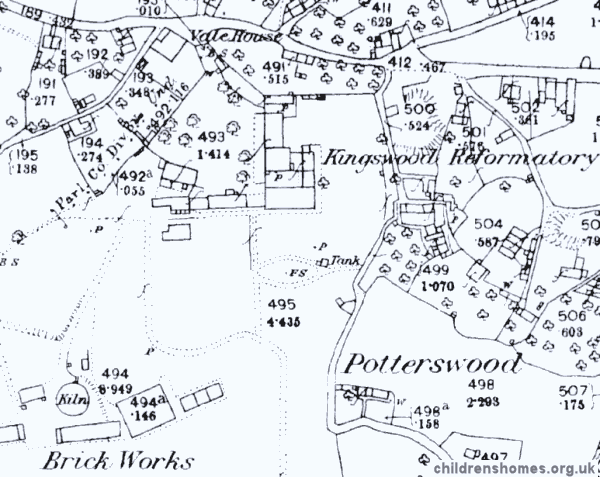
Kingswood Reformatory site, c.1882.
There were soon problems for the new institution. In July, 1853, nine boys absconded. An early inspection report noted that the buildings were scattered and unsuited for for their purpose, with effective supervision being almost impossible. The master was said to have too many registers and journals to keep, keeping him needlessly employed in his office rather in the school. In 1857, the master resigned after becoming disheartened when a number of his charges absconded at the same time. His replacement, Mr Barker, appeared to set the establishment on a better footing.
As was usual in Reformatory Schools, the boys received both classroom education and industrial training. The latter included farm work, gardening, shoe making and tailoring. A new and financially profitable occupation was introduced in 1867 with the construction at the south of the site of a large shed for tile and brick making, with a furnace underneath. A tank holding 140,000 gallons of water had also been dug to supply the School and brickfield. The following year saw improvements to the School premises including an enlargement of the dining room, the building of a new kitchen, the fitting out of a laundry, bathroom and lavatory, and better ventilation of the dormitories. Brick making was discontinued in 1884 and replaced by trades such carpentry, blacksmithing and the making of chip baskets.
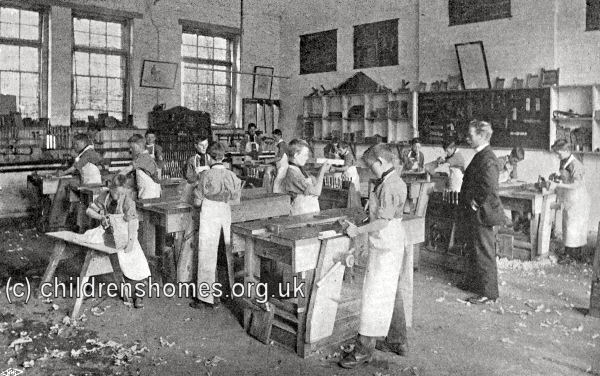
Kingswood Reformatory carpentry workshop, c.1901. © Peter Higginbotham
In 1891-2, there was an almost complete rebuilding of the premises. The new building was U-shaped, enclosing a large central courtyard, as shown on the 1903 map below.
The location of the home is shown on the 1903 map below.

Kingswood Reformatory for Boys site, Bristol, c.1903.

Kingswood Reformatory and Master's House, from the south-east, c.1905. © Peter Higginbotham
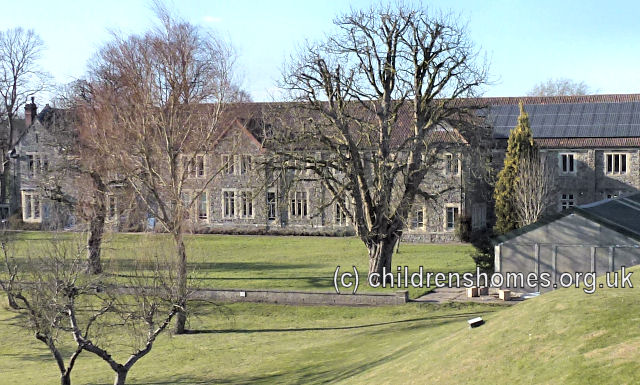
Kingswood Reformatory and Master's House, from the south, 2013. © Peter Higginbotham
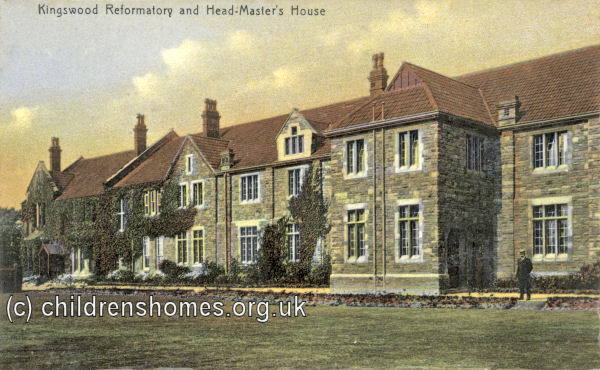
Kingswood Reformatory and Master's House, from the south-east, c.1905. © Peter Higginbotham
Virtually the only part of the buildings not to be replaced in the rebuild was John Wesley's Chapel, at the north end of the east range.

Kingswood Reformatory Wesley Chapel, from the south-west, c.1905. © Peter Higginbotham
In addition to their other activities, boys at the Kingswood performed military-style drill. Those with any musical aptitude could join the School's band. The picture below shows the boys and band on parade, with the School's east range behind.
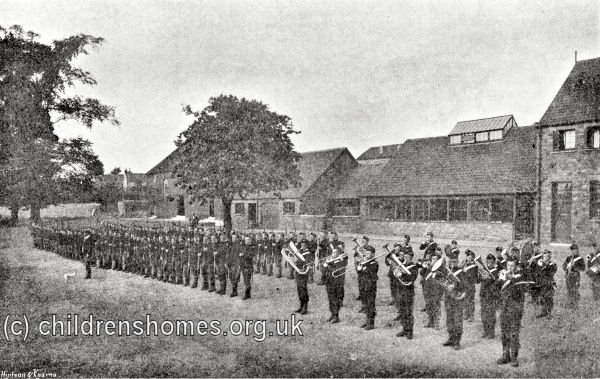
Kingswood Reformatory boys on parade, c.1901. © Peter Higginbotham
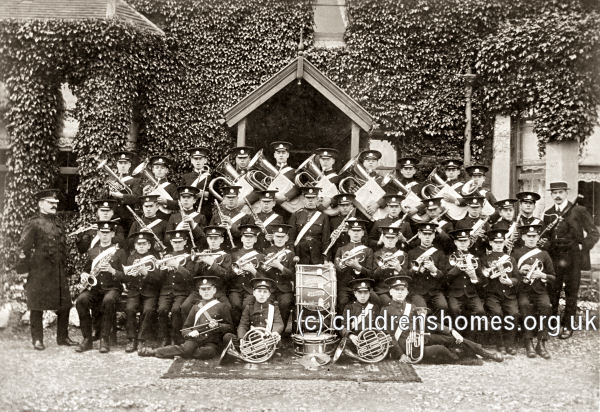
Kingswood Reformatory band, early 1900s. © Peter Higginbotham
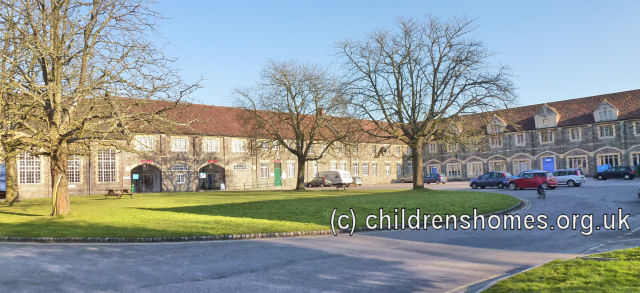
Kingswood Reformatory east and south ranges from the north-west, 2013. © Peter Higginbotham
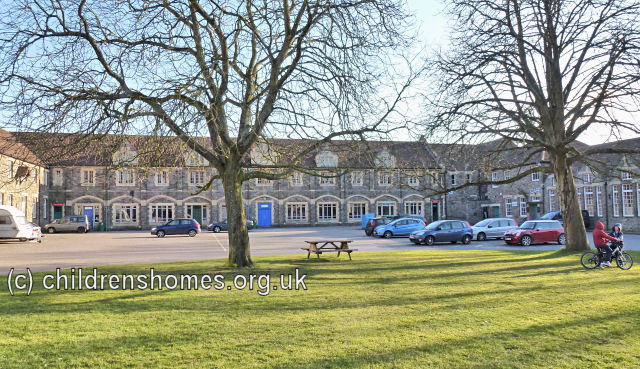
Kingswood Reformatory east and south ranges, from the north-west, 2013. © Peter Higginbotham
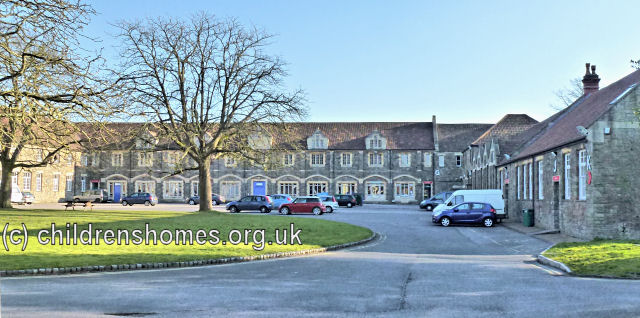
Kingswood Reformatory south and west ranges from the north, 2013. © Peter Higginbotham
Sport and gymnastics also featured on the School curriculum. In 1907, the Kingswood was runner up in both the football and cricket challenge cups in the Home Office League. In the same year, fifty boys passed out as being able to swim.
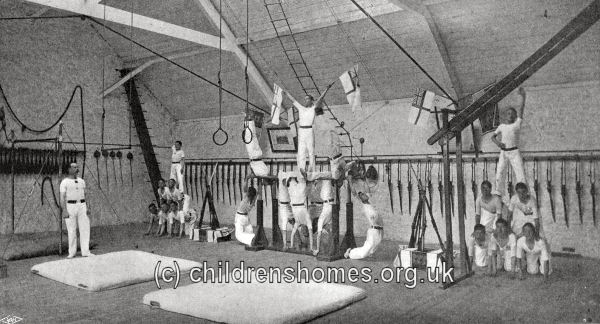
Kingswood Reformatory boys' gymnastics display, c.1901. © Peter Higginbotham
In June 9, 1903, the School established an Auxiliary Home in a house known as Fairlawn, at 23 Montague Hill, Bristol. It could accommodate up to 20 boys who had obtained employment in the city, prior to their final release from Kingswood.
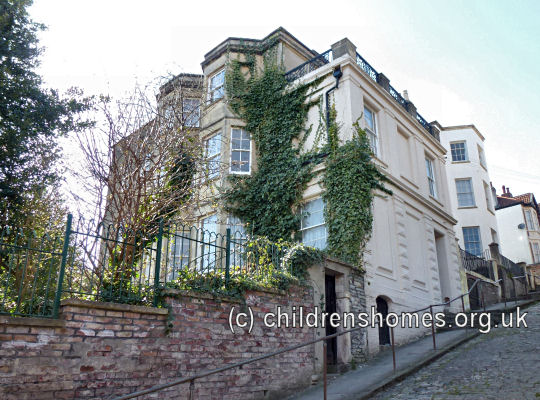
Former Kingswood Auxiliary Home, Bristol, 2013. © Peter Higginbotham
Some of the boys leaving Kingswood emigrated. As early as 1854, three boys from the School, having the appearance of rough farm lads, drew comment when they and their escort were seen boarding a first class carriage on a train taking them from Birmingham to Liverpool, en route to employment in the United States. The lads, upon entering it, appeared highly delighted with their luxurious position and caused much amusement to bystanders by their observations and gestures. In 1907, it was noted that grants given to boys to fund their emigration were expected to be repaid as a 'debt of honour'.
Further developments took place in the buildings over the years, particularly in the east wing. The Wesley chapel, which had fallen into a serious state of disrepair, was demolished in 1919.
In 1933, Kingswood became an Approved School, one of the new institutions introduced by the 1933 Children and Young Persons Act to replace the existing system of Reformatories and Industrial Schools. The Kingswood Training School, as it was officially known, could accommodate up to 120 Senior Boys aged 14 to 16. The training offered by the School then included farming, gardening, cabinet-making and the building trade. It later took on the role of a Classifying School, assessing the 'character, mental attainments and physical abilities' of new entrants into the Approved School system and deciding which institution would then best meet their needs.
In 1951, a new bell was installed at Kingswood which was recast from the metal of the one used at the Wesley's original School on the site.

Kingswood School recast bell, 2013. © Peter Higginbotham
In 1964, the establishment was reorganised to comprise a Classifying School (56 places) for assessing new entrants to the Approved School system, an Intermediate Training School (105 places), and Special Unit (20 places) for boys with severe behavioural problems.
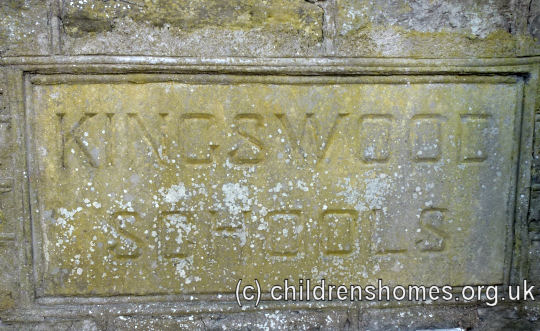
Kingswood Schools entrance plaque, 2013. © Peter Higginbotham
In 1973, the Schools became a Community Home with Education (CHE) under the control of Avon County Council.
With falling numbers, a gradual closing of the training school began in 1981. In 1991, the now empty main building was severely damaged by fire. The site was then handed over the Kingswood Foundation who sold off part of the land for the building of the new John Cabot City Technology College. The proceeds were used to refurbish the old buildings, sections of which were then let to organisations involved in arts-related activities for young people. In 2011, the Kingswood Foundation was renamed Creative Youth Network and moved its base to The Station, a new art youth centre in central Bristol.
Records
Note: many repositories impose a closure period of up to 100 years for records identifying individuals. Before travelling a long distance, always check that the records you want to consult will be available.
- Bristol Record Office, 'B' Bond Warehouse (in the 'Create Centre' section from 3-Dec-2013), Smeaton Road, Bristol BS1 6XN. Holdings include: Minutes and reports (1890-1949); Admissions registers (1898-1936); Discharge registers (1900-1917); reports on boys (1927-35); Punishment book (1911-36); Scrapbook (1898); Newscuttings (1926-32).
Census
Bibliography
- Carpenter, Mary Reformatory Schools for the Children of the Perishing and Dangerous Classes, and for Juvenile Offenders (1851)
- Carpenter, Mary Reformatory Schools, for the Children of the Perishing and Dangerous Classes, and for Juvenile Offenders (1851, General Books; various reprints available)
- Carlebach, Julius Caring for Children in Trouble (1970, Routledge & Kegan Paul)
- Higginbotham, Peter Children's Homes: A History of Institutional Care for Britain's Young (2017, Pen & Sword)
- Abel Smith, Doroth Crouchfield: A History of the Herts Training School 1857-1982 (2008, Able Publishing)
- Garnett, Emmeline Juvenile offenders in Victorian Lancashire: W J Garnnett and the Bleasdale Reformatory (2008, Regional Heritage Centre, Lancaster University)
- Hicks, J.D. The Yorkshire Catholic Reformatory, Market Weighton (1996, East Yorkshire Local History Society)
- Slocombe, Ivor Wiltshire Reformatory for Boys, Warminster, 1856-1924 (2005, Hobnob Press)
- Duckworth, J.S. The Hardwicke Reformatory School, Gloucestershire (in Transactions of the Bristol and Gloucestershire Archaeological Society, 1995, Vol. 113, 151-165)
- Higginbotham, Peter Children's Homes: A History of Institutional Care for Britain's Young (2017, Pen & Sword)
- Hyland,Jim Yesterday's Answers: Yesterday's Answers: Development and Decline of Schools for Young Offenders (1993, Whiting and Birch)
- Millham, S, Bullock, R, and Cherrett, P After Grace — Teeth: a comparative study of the residential experience of boys in Approved Schools (1975, Chaucer Publishing)
Links
- Kingswood Foundation / Creative Youth Network
- Red Lodge Museum, Bristol — a former girls' reformatory.
Except where indicated, this page () © Peter Higginbotham. Contents may not be reproduced without permission.


